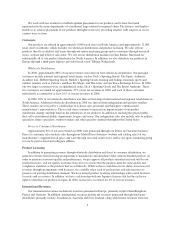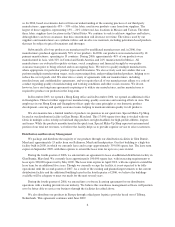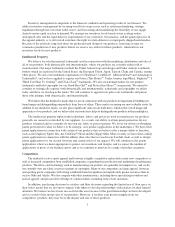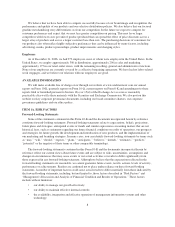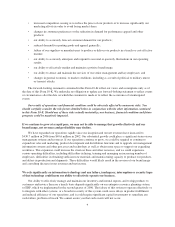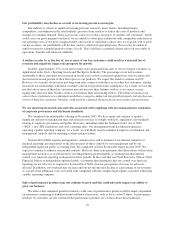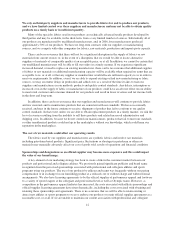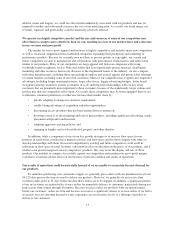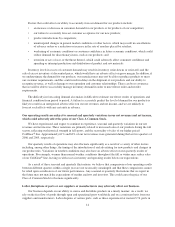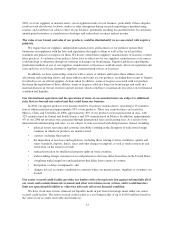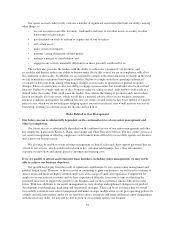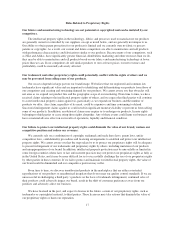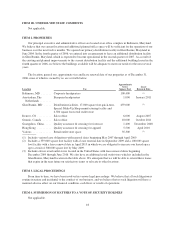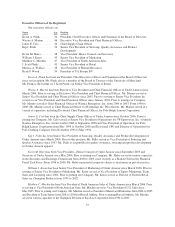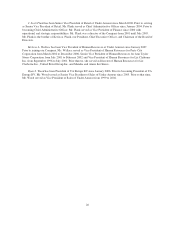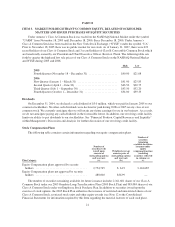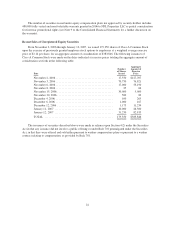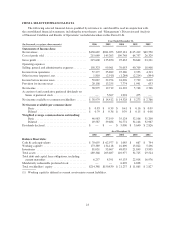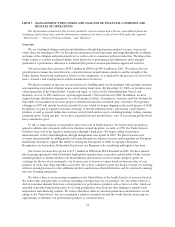Under Armour 2006 Annual Report Download - page 22
Download and view the complete annual report
Please find page 22 of the 2006 Under Armour annual report below. You can navigate through the pages in the report by either clicking on the pages listed below, or by using the keyword search tool below to find specific information within the annual report.Factors that could affect our ability to accurately forecast demand for our products include:
• an increase or decrease in consumer demand for our products or for products of our competitors;
• our failure to accurately forecast customer acceptance for our new products;
• product introductions by competitors;
• unanticipated changes in general market conditions or other factors, which may result in cancellations
of advance orders or a reduction or increase in the rate of reorders placed by retailers;
• weakening of economic conditions or consumer confidence in future economic conditions, which could
reduce demand for discretionary items, such as our products; and
• terrorism or acts of war, or the threat thereof, which could adversely affect consumer confidence and
spending or interrupt production and distribution of product and raw materials.
Inventory levels in excess of customer demand may result in inventory write-downs or write-offs and the
sale of excess inventory at discounted prices, which would have an adverse effect on gross margin. In addition, if
we underestimate the demand for our products, our manufacturers may not be able to produce products to meet
our customer requirements, and this could result in delays in the shipment of our products and our ability to
recognize revenue, as well as damage to our reputation and customer relationships. There can be no assurance
that we will be able to successfully manage inventory demand in order to meet future order and reorder
requirements.
The difficulty in forecasting demand also makes it difficult to estimate our future results of operations and
financial condition from period to period. A failure to accurately predict the level of demand for our products is
likely to result in an unexpected adverse effect on our net revenues and net income, and we are unlikely to
forecast such effects with any certainty in advance.
Our operating results are subject to seasonal and quarterly variations in our net revenues and net income,
which could adversely affect the price of our Class A Common Stock.
We have experienced, and expect to continue to experience, seasonal and quarterly variations in our net
revenues and net income. These variations are primarily related to increased sales of our products during the fall
season, reflecting our historical strength in fall sports, and the seasonality of sales of our higher priced
ColdGear®line. Approximately 61% and 62% of our net revenues were generated during the last two quarters of
2006 and 2005, respectively.
Our quarterly results of operations may also fluctuate significantly as a result of a variety of other factors,
including, among other things, the timing of the introduction of and advertising for new products and changes in
our product mix. Variations in weather conditions may also have an adverse effect on our quarterly results of
operations. For example, warmer than normal weather conditions throughout the fall or winter may reduce sales
of our ColdGear®line, leaving us with excess inventory and operating results below our expectations.
As a result of these seasonal and quarterly fluctuations, we believe that comparisons of our operating results
between different quarters within a single year are not necessarily meaningful and that these comparisons cannot
be relied upon as indicators of our future performance. Any seasonal or quarterly fluctuations that we report in
the future may not match the expectations of market analysts and investors. This could cause the price of our
Class A Common Stock to fluctuate significantly.
Labor disruptions at ports or our suppliers or manufacturers may adversely affect our business.
Our business depends on our ability to source and distribute products in a timely manner. As a result, we
rely on the free flow of goods through open and operational ports worldwide and on a consistent basis from our
suppliers and manufacturers. Labor disputes at various ports, such as those experienced at western U.S. ports in
14


